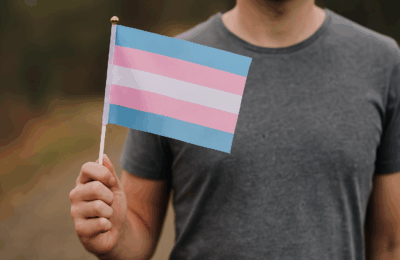Part 1 of Gender and Sexuality
Scripture: Genesis 1:27
In our contemporary culture, few truths are as countercultural – or as contested – as the biblical statement that “male and female He created them” (Gen 1:27, LSB). What was once taken for granted – that humanity exists as two complementary sexes by God’s design – is now at the center of social conflict and confusion. Christians find themselves in a world where saying “men and women are created different, by God’s intent” can spark controversy. This is not merely a human societal debate; it is part of a deeper spiritual battle. Scripture reveals that the question of gender identity and purpose lies at the heart of a cosmic conflict between God’s truth and Satan’s lies. In this first article of our four-part series on gender and sexuality, we will explore God’s creational design for male and female, and see how it is not only a foundational truth of the Christian worldview but also a front line in the spiritual war raging for the souls of humanity. Our aim is to understand God’s design for gender from Genesis, appreciate the dignity and purpose He imbued in creating us male and female, and recognize why this design is so fiercely attacked by rebellious spiritual powers. Equipped with a biblical worldview, we can then stand firm in truth and love amid today’s gender confusion, knowing the significance of our calling as God’s image-bearers.
The Good Creation: Male and Female in God’s Image
The Bible opens with the majestic account of creation, and at its pinnacle, we find the creation of humanity: “God created man in His own image, in the image of God He created him; male and female He created them” (Gen 1:27, LSB). In just one verse, Scripture asserts both the unity and the duality of humankind – we are one humanity, uniquely bearing God’s image, and yet we are expressed as two sexes, male and female, by God’s intentional design. This foundational truth carries profound implications.
First, being made “in the image of God” (imago Dei) is what gives every human being inherent value and dignity. Unlike the rest of creation, men and women are imagers of God – created to represent Him on earth. As theologian Michael Heiser explains, God created humanity as His image, meaning we are meant to mirror God’s character and steward His creation as His representatives (Heiser, 2015, pp. 42–43). Immediately after stating that He made humanity male and female, God blessed them and gave them the cultural mandate: “Be fruitful and multiply and fill the earth and subdue it, and rule over [it]” (Gen 1:28, LSB). In other words, our dual-gendered humanity is integral to God’s plan – only through male and female together could God’s image-bearers “be fruitful and multiply … fill [the earth]”, extending God’s reign throughout creation (Heiser, 2015, p. 43). From the beginning, God’s design of two sexes was very good (Gen 1:31), intended to work in harmony for the flourishing of human life and the reflection of God’s glory.
Secondly, Genesis teaches that both man and woman fully share the image of God and thus are equal in value before Him. There is no hint of one sex being superior; “male and female He created them” links directly to being in God’s image, indicating that women and men alike possess equal dignity, worth, and personhood as image-bearers (Grudem, 2020, p. 515). The Apostle Paul later underlines this equality in redemption, noting that in Christ, “there is neither male nor female” in regard to our status as God’s children (Gal 3:28) – we are “fellow heirs of the grace of life” (1 Pet 3:7). Any view that treats one sex as less important or less human is a distortion of the biblical truth that both were created in God’s likeness. As one theologian succinctly put it, “men and women have been created in the image of God to be equal in personhood and importance” (Grudem, 2018, p. 220). Therefore, Christians affirm both the equal worth of men and women and the distinctiveness with which God created each.
Indeed, the very distinctiveness of male and female is part of the Creator’s good design. In Genesis 2, we get a closer look at how God formed the first man and woman. God said, “It is not good for the man to be alone; I will make him a helper suitable for him” (Gen 2:18, LSB). None of the animals were an adequate partner for Adam. So God made Eve from Adam’s side – equal in humanity, corresponding to him in likeness, and complementary in her differences. Adam recognizes this joyful reality, exclaiming, “This is now bone of my bones, and flesh of my flesh” (Gen 2:23). The term “helper suitable” (Hebrew ezer kenegdo) does not imply inferiority; rather, it signifies a complementary partner – one who supplies what is lacking in the other, so that together they form a greater whole. In God’s blueprint, man and woman fit together physically, emotionally, and spiritually. This complementary design is wonderfully purposeful: through the union of husband and wife, God would bring forth new life (Gen 1:28) and model the kind of self-giving love that ultimately reflects Christ’s love for His Church (Eph 5:25–32). As John MacArthur notes, our society may try to “fit men and women into the same interchangeable mold,” but God “divinely designed each sex with unique qualities and strengths” (MacArthur, 2006). The differences between male and female – from chromosomes to physiology to emotional and spiritual wiring – are not mistakes or mere cultural constructs; they are part of the gift of God’s creation.
Sadly, our culture often either denies these God-given differences or distorts them. But a biblical worldview calls us to celebrate the goodness of God’s design. Every boy and girl can rejoice that God made them purposefully male or female (Psalm 139:13–14), and every adult can find freedom in embracing the identity God has assigned rather than trying to self-define. Christian ethicist Wayne Grudem points out that Scripture teaches only two sexes – male and female – and expects that our gender identity follow the biological sex God sovereignly chose for each of us (Grudem, 2018, pp. 877–880). Even science confirms this binary reality of sex encoded in our DNA (XX or XY chromosomes) (Grudem, 2018, p. 878). For a culture awash in confusion, Genesis provides clarity: humanity is male or female by God’s intentional design, and both sexes are needed to fully image God and carry out our mandate on earth. In sum, gender is a sacred gift, rooted in creation. It is not fluid, self-determined, or arbitrary – it is part of the order of creation established by a loving God for our good and His glory.
Spiritual Warfare Against God’s Design
Why, then, is something as beautiful as God’s design for gender under such attack? Why has the clear creational distinction of male and female become clouded by confusion, rebellion, and pain? The Bible’s answer is that we find ourselves in the middle of a cosmic spiritual conflict. From the very beginning, God’s design in creation – including the creation of male and female in His image – has been the target of sabotage by God’s enemy. Spiritual warfare is not merely the stuff of sensational stories; it is the unseen reality behind the corruption of God’s good creation. The distortion of gender and sexuality is one front in the broader war between God’s kingdom and the “kingdom of darkness” (Col 1:13). Let’s pull back the curtain of history and Scripture to see how this battle has unfolded.
It starts in Eden. No sooner had God pronounced His creation “very good” and set Adam and Eve in the garden, than a spiritual adversary entered the scene. In Genesis 3, the serpent (identified later as Satan; cf. Rev 12:9) deceived Eve and enticed the first humans to sin. This was not a mere talking snake with a grudge – it was a rebel from God’s heavenly host, a fallen spiritual being, leading an insurrection against the Creator (Heiser, 2015, pp. 82–83). The temptation was to disregard God’s word and become “like God” on their own terms (Gen 3:5). When Adam and Eve fell, the consequences were devastating: not only spiritual death and separation from God, but also a fracturing of the harmony between man and woman. God’s verdict included that the relationship would now be marked by strife: “Your desire will be for your husband, and he will rule over you” (Gen 3:16). This indicates that the once-perfect partnership would be marred by a struggle for control and a breakdown of the loving leadership and responsive support that God intended. In other words, the first casualty in the war on God’s design was the unity of the first marriage. The enemy successfully injected discord into the male-female relationship.
From that point on, Scripture reveals an ongoing strategy of Satan to attack and distort God’s design for sexuality, marriage, and family. In Genesis 6:1–4, we see a strange account of “the sons of God” taking human women as wives, leading to great wickedness on the earth. While mysterious, this passage is understood by many scholars (and ancient interpreters) as another incursion of fallen angels – a further attempt by spiritual rebels to corrupt humanity, this time through an abuse of sexuality and procreation (Heiser, 2015, pp. 102–104). The result was an explosion of depravity and violence (Gen 6:5), requiring God’s judgment in the flood. Whether one finds this episode perplexing or not, the pattern is consistent: rebellious spirits seek to pervert human sexuality and the male-female union, knowing it is central to God’s plan. After the flood, in the incident at Babel (Gen 11), humanity again rebelled, and God scattered the nations. Deuteronomy 32:8 hints that God allowed the nations to go under the influence of lesser “gods” – spiritual powers that became false deities of the pagan world (Heiser, 2015, pp. 113–119). These powers led cultures away from the Creator, often promoting gross sexual immorality and distortions of gender in their idol worship. (For example, many ancient fertility cults blurred gender roles and used temple prostitution – a demonic parody of God’s design for sex within marriage.)
Against this dark backdrop, God began His plan to redeem and restore, calling Abraham and eventually birthing the nation of Israel, through whom the Messiah would come. Yet the war raged on. Throughout Israel’s history, pagan religions – inspired by demonic powers (1 Cor 10:20) – constantly lured God’s people into sexual perversion and confusion of roles. The prophets often link idolatry with adultery or sexual deviance, showing how departing from God’s order leads to disordered relationships (e.g., Hosea 4:12–14). One striking New Testament insight is that false teachings in later times would encourage “forbidding marriage” as a doctrine of demons (1 Tim 4:1–3). In other words, Satan’s tactics can swing between promoting licentiousness on one hand, and promoting a rejection of God’s good gifts (like marriage between man and woman) on the other. In both cases – whether through sensual indulgence or ascetic denial – the aim is to undermine God’s creational design for male and female, marriage and family.
Fast forward to the New Testament era: the promised Savior, Jesus Christ, enters a world marred by this battle. He comes to “destroy the works of the devil” (1 Jn 3:8) and to reclaim what was lost. Notably, Jesus reaffirms God’s original design for gender and marriage. When questioned about divorce, He points back to Genesis: “Have you not read that He who created them from the beginning made them male and female” (Matt 19:4, LSB). He then quotes Genesis 2:24, underscoring that marriage is a male-female one-flesh union ordained by God. In doing so, Jesus makes clear that despite human hard-heartedness or cultural drift, God’s creation order remains the standard. Jesus recognized that the male-female distinction was not a mere custom of ancient times but a divine mandate “from the beginning.” This was, in effect, spiritual warfare by truth – Christ upholding the Creator’s blueprint in the face of human deviation.
The ultimate victory in the cosmic conflict was won by Christ at the cross and empty tomb. In His death and resurrection, Jesus not only provided salvation for sinners but “disarmed the rulers and authorities” in the spiritual realms (Col 2:15). The head of the serpent was crushed, in fulfillment of God’s ancient promise that the offspring of the woman would bruise the serpent’s head (Gen 3:15). Yet, even though Satan is a defeated foe, he has not conceded defeat. Scripture says he “prowls around like a roaring lion, seeking someone to devour” (1 Pet 5:8). One of his ongoing tactics is the propagation of lies about our identity. Jesus called Satan “a liar and the father of lies” (John 8:44). Among those lies in our time is the idea that “male and female” are arbitrary or fluid categories, that our bodies are accidents of nature unrelated to our true selves, or that we can define our own identity apart from God. These deceptions strike at the very heart of what it means to be human in God’s image.
Behind the modern confusion about gender, we must discern the shadowy hand of the ancient serpent. We do not wrestle merely with social trends or human ideologies, “but against the rulers, against the powers, against the world forces of this darkness, against the spiritual forces of wickedness in the heavenly places” (Eph 6:12). The Christian view is that a spiritual war underlies the cultural war. The surge of radical gender ideology – which claims that being male or female is not rooted in biology or divine design but in subjective feelings – bears the fingerprints of our adversary, who from Eden onward has tried to usurp God’s authority and “exchange the truth of God for a lie” (Rom 1:25). The growing phenomenon of people (including children) experiencing gender dysphoria – a distressing disconnect between their biological sex and their internal sense of self – must be seen with compassionate understanding and with spiritual discernment. We grieve with those who suffer, but we recognize that the solution the world offers (to “change” one’s gender or redefine reality) is just another of Satan’s lies to keep people from embracing the truth of God’s creation. As Michael Heiser insightfully notes, humanity’s role as God’s image-bearers made us the target of free-will rebellions among God’s own heavenly beings . These rebels knew that if they could mar or confuse the image of God in mankind, they could tarnish God’s glory on earth. Distorting human sexuality and identity is a prime way to do just that. Thus, every deviation from God’s design – whether it be the abuse of sex outside marriage, the distortion of gender roles, or the denial of the reality of male and female – ultimately serves the enemy’s agenda of robbing God of glory and destroying God’s beloved creation (John 10:10).
The good news is that God has not left us defenseless. In Christ, we have authority over deceitful spirits and the renewing power of the Holy Spirit to transform minds (Rom 12:2). We engage this spiritual battle not with hatred or worldly weapons, but with the armor of God (Eph 6:13–18): the belt of truth (including truths about creation), the shield of faith (trusting God’s word over cultural lies), and the sword of the Spirit which is the Word of God. Every time we affirm the truth of Genesis 1:27 – that humanity is created male and female with divine purpose – we wield a powerful weapon against the devil’s schemes. We stand in the authority of God’s Word to declare that our identity is a gift from God, not a fabrication of our own will or the devil’s whim. The spiritual war for gender is ultimately a war for the image of God in humanity. And on that front, we already know who wins: our Creator and Redeemer, the Lord Jesus Christ.
Embracing Biblical Truth in a Confused Culture
Given this cosmic backdrop, how do we then live and minister in a culture deeply confused about gender and sexuality? The challenges are enormous and often heart-wrenching: parents confronting a child’s identity crisis, churches grappling with societal pressure to compromise biblical teaching, individuals torn between the lives they’ve been told will make them happy and the truth that seems too demanding. Yet, into this confusion, the light of Scripture still shines, offering clarity, compassion, and hope. As disciples of Christ, we are called to speak the truth in love (Eph 4:15) and to hold fast to the Word of life (Phil 2:15–16) for the sake of a generation groping in darkness.
Firstly, we must renew our own minds according to God’s Word. Too often, even Christians have been influenced by unbiblical ideologies about gender. We need to consciously build our thinking on the foundation of Scripture. This means affirming what Scripture teaches from Genesis to Revelation: that our bodies are fearfully and wonderfully made by God (Psalm 139:14), that maleness and femaleness are sacred (not interchangeable or dismissible), and that our identity is ultimately grounded in our relationship to God, not our subjective feelings. In a poignant observation, theologian Carl Trueman notes how dramatically the Western view of self has shifted: “Our grandparents would have heard [the statement] ‘I am a woman trapped in a man’s body’ with blank incredulity. But now it’s supposed to be taken very seriously indeed” (Trueman, 2020, p. 19). This change did not happen in a vacuum; it came about because society embraced what philosopher Charles Taylor calls expressive individualism – the idea that the individual’s inner feelings are the truest guide to reality. We must recognize this for what it is: a false gospel. The world says “look within to find your true self”, but the Word says “look to your Creator to find your true self.” As Christopher Yuan writes, our sense of self (feelings) may describe how we feel, but it does not define who we are (Yuan, 2018, p. 21). Our Creator defines who we are. Yuan, who left a homosexual lifestyle to follow Christ, testifies that he had to surrender the labels the world gave him. “My identity is not ‘gay’ or ‘ex-gay’ or even ‘straight.’ My true identity is in Jesus Christ alone” (Yuan, 2018, p. 25). What a powerful reminder that for all of us, our fundamental identity is not in our sexual attractions, gender feelings, or any other human category – it is in being a child of God, made in His image and redeemed by Christ. Embracing that identity is liberating.
Secondly, we must approach those confused about or struggling with gender with Christ-like compassion and conviction. Remember that our ultimate adversary is Satan, not the individuals who may oppose biblical teaching. Those individuals are souls Christ died for, often deeply hurting or deceived. A “culture of death” (to borrow Pope John Paul II’s term) has been promoted by the enemy – a culture that says bodily life and created order have no inherent meaning. We are called to foster a culture of life. This means we uphold the sanctity and goodness of the human body and the God-ordained distinction of male and female, while reaching out in love to those caught in the lies of the culture of death. When someone says “I feel trapped in the wrong body,” instead of scorn or simplistic retorts, we offer a listening ear and gentle truth: “I believe God made you for a reason, and He loves you as the person you actually are. Let’s explore why you feel this way and what God’s word might say about it.” We can affirm the very real pain such a person experiences (the distress of dysphoria is not imaginary) but also gently point them to the reality that our feelings, as real as they are, can mislead us due to the Fall (Jer 17:9). All of us have disordered desires of some kind due to sin; gender dysphoria is one manifestation of our groaning for redemption. But thanks be to God, Christ offers new creation: “If anyone is in Christ, he is a new creation” (2 Cor 5:17). There is hope and healing in Jesus. We have seen individuals with gender confusion find clarity and peace by coming to know Christ and accepting the body He gave them. Our churches should be places where the beauty of God’s design is taught and where grace abounds for those struggling. It is not loving to affirm a harmful lie; nor is it loving to shun someone ensnared by lies. True love, as Jesus modeled, is full of grace and truth (John 1:14).
Practically, upholding biblical truth in this area may bring us into conflict with society’s norms. We must be prepared, with humility and courage, to be seen as “odd” or even “the bad guys” by a world that calls evil good and good evil (Isa 5:20). We do so not with a combative spirit, but with a firm resolve to obey God rather than men (Acts 5:29). This might mean making difficult stands – for example, declining to use pronouns that contradict a person’s God-given sex, if doing so would affirm a lie (Grudem, 2018, p. 880). It might mean teaching our children early and often that “Male and female He created them” is a truth fundamental to who we are. It might mean graciously resisting policies in our workplaces or schools that compel participation in untruth. We must do all this with respect and gentleness (1 Pet 3:15), but also with an unyielding commitment to biblical authority. The moment we allow the culture to redefine what God has clearly defined, we ourselves step out from under the protective umbrella of God’s truth. Remember, the spiritual war is ultimately won by faithfulness to God’s Word (Rev 12:11). Every believer, whether a parent, a pastor, or a young student, has a role in this stand. By living out and speaking out God’s design for men and women, we bear witness to the world of a better way – one that leads to life, not further confusion and harm.
It’s also worth highlighting the positive vision we have to offer. The Christian worldview doesn’t just say “No” to the world’s errors; it also extends a beautiful “Yes” to God’s plan. We can joyfully cast a vision of men and women partnering together in unity and love, of marriages that thrive as each spouse embraces their God-given role, of single men and women who honor God with their bodies and find family in the church, of children raised with the security of a mom and a dad who love them and model godliness. In short, we uphold what Michael Heiser and others have called “the Edenic vision” – life as God intended, under His blessing. While we live in a fallen world and none of us perfectly lives out God’s design, the more we align with it, the more human flourishing we experience. As Yuan (2018) points out, God’s commands about sex and identity are not arbitrary rules; they are roadmaps to human flourishing. Holy sexuality – chastity in singleness and faithful love in marriage between a man and a woman – is “a key to human flourishing” under God’s grand design (Yuan, 2018, p. 35). We should confidently assert that the biblical ethic leads to greater joy, peace, and wholeness than the chaos of self-definition and sexual anarchy. Numerous testimonies exist of people who left behind transgender or homosexual lifestyles and found true joy in Christ. Their lives shine as beacons of hope that the truth really does set us free (John 8:32).
Conclusion
Genesis 1:27 stands as a bedrock for understanding who we are: creatures made by God, in His image, as male and female, for His glory and our good. In this first installment of our series on gender and sexuality, we have seen that this creational truth is not only a matter of theological fact but also a matter of spiritual warfare. The rebellion that began in Eden continues in the lies of today, but God’s truth has not changed. As we move forward in this series, we will build on this foundation – examining how Christ brings redemption to our sexual brokenness, how the church can minister in a sexually confused age, and how we can cultivate a biblical worldview that stands firm against cultural pressures.
Let us take heart: we are on the side of the victorious King. God’s design will ultimately be vindicated. In the age to come, redeemed humanity – men and women from every tribe and tongue (Rev 7:9) – will together bear God’s image in resurrection glory, perfectly reflecting His character. The maleness or femaleness that God bestowed on each of us will be part of our eternal worship and service to Him, no longer as points of tension but in total harmony. Until that day, we are called to be salt and light (Matt 5:13–16), testifying to God’s design in a world that desperately needs the truth. We must not falter in declaring, with both conviction and compassion, that “male and female He created them.” In doing so, we join the frontline of the good fight – not against flesh and blood, but against falsehood and the forces of darkness – armed with the unchanging Word of our Creator. May we, the church, foster a culture of life amid a culture of death, holding forth the hope that in Jesus Christ, confused hearts can find clarity, broken lives can be restored, and the goodness of God’s design can be joyfully embraced once more.
Next → Understanding LGBTQ+: Compassion Without Compromise
View all of Gender and Sexuality
References:
- Grudem, W. (2018). Christian Ethics: An Introduction to Biblical Moral Reasoning. Wheaton, IL: Crossway.
- Grudem, W. (2020). Systematic Theology: An Introduction to Biblical Doctrine (2nd ed.). Grand Rapids, MI: Zondervan Academic.
- Heiser, M. S. (2015). The Unseen Realm: Recovering the Supernatural Worldview of the Bible. Bellingham, WA: Lexham Press.
- MacArthur, J. F. (2006). Divine Design: God’s Complementary Roles for Men and Women. Colorado Springs, CO: David C. Cook.
- Trueman, C. R. (2020). The Rise and Triumph of the Modern Self: Cultural Amnesia, Expressive Individualism, and the Road to the Sexual Revolution. Wheaton, IL: Crossway.
- Yuan, C. (2018). Holy Sexuality and the Gospel: Sex, Desire, and Relationships Shaped by God’s Grand Story. Colorado Springs, CO: Multnomah.








